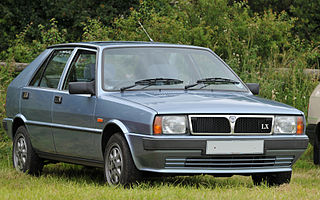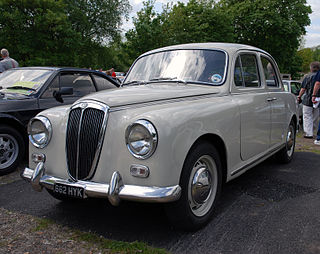
The Lancia Delta is a small family car produced by Italian automobile manufacturer Lancia in three generations. The first generation (1979-1994) debuted at the 1979 Frankfurt Motor Show, the second generation (1993-1999) debuted at the 1993 Geneva Motor Show, and the third generation (2008-2014) debuted at 2008 Geneva Motor Show.

Front-wheel drive (FWD) is a form of engine and transmission layout used in motor vehicles, where the engine drives the front wheels only. Most modern front-wheel-drive vehicles feature a transverse engine, rather than the conventional longitudinal engine arrangement generally found in rear-wheel-drive and four-wheel drive vehicles.

The Lancia Fulvia is an automobile produced by Lancia between 1963 and 1976. Named after Via Fulvia, the Roman road leading from Tortona to Turin, it was introduced at the Geneva Motor Show in 1963 and manufactured in three variants: Berlina 4-door saloon, 2-door Coupé, and Sport, an alternative fastback coupé designed and built by Zagato on the Coupé floorpan.

The Lancia Delta S4 is a Group B rally car manufactured by the Italian car company Lancia. The Delta S4 competed in the World Rally Championship in 1985 and 1986, until Group B class was disbanded and the cars were eventually banned from competition completely by European sanctioning body FIA. The car replaced, and was an evolution of the 037. The S4 took full advantage of the Group B regulations, and featured a midship-mounted engine and all-wheel drive for superior traction on loose surfaces.

The Lancia Rally was a mid-engine sports car and rally car built by Lancia in the early 1980s to compete in the FIA Group B World Rally Championship. Driven by Markku Alén, Attilio Bettega, and Walter Röhrl, the car won Lancia the manufacturers' world championship in the 1983 season. It was the last rear-wheel drive car to win the WRC.

The Lancia Appia was a passenger car introduced in 1953 by Italian car manufacturer Lancia as a replacement for the Ardea, and which remained in production for ten years. The Appia was the last in a long line of Lancia production cars dating back to the Lancia Lambda to use the famous sliding pillar front suspension. All three series produced had a Lancia V4 engine of 1089 cc.

The ALFA 24 HP is 4.1-litre four-cylinder passenger car, the first model produced by Italian car manufacturer ALFA, which in 1919 would become Alfa Romeo. It was introduced in 1910, the year ALFA was founded, and produced until 1914 in ALFA's Portello factory near Milan. The model's name comes from its tax horsepower rating, then frequently used as vehicle designation.

The Lancia Ardea was a small family car produced by Italian car manufacturer Lancia between 1939 and 1953. Its unusually short bonnet reportedly contained the smallest V4 engine ever commercialized in a small family car

The Lancia Artena is a passenger car produced by Italian car manufacturer Lancia from 1931 to 1936, and from 1940 to 1942 chiefly for army and government use. It was powered by a 2-litre Lancia V4 engine, while chassis and factory bodies were shared with the more luxurious 2.6-litre V8-engined Lancia Astura. Total production amounted to 5,567 examples.

The Lancia 20/30 HP, later known as Lancia Epsilon, is a passenger car produced by Italian car manufacturer Lancia between 1911 and 1912. The car was quite similar to the previous 20/30 HP Delta model. In total 357 were made.
The Rolls-Royce 30 hp was one of four cars to be produced as a result of an agreement of 23 December 1904 between Charles Rolls and Henry Royce. Badged as a Rolls-Royce, the 30 hp was produced during 1905 and 1906 by Royce's company, Royce Ltd. at its factory in Cooke Street, Hulme, Manchester. It was sold exclusively by Rolls' motor dealership, C.S.Rolls & Co., at a price of GBP 890. The engine was exhibited at the Paris Salon in December 1904, along with the 10 hp, 15 hp and 20 hp models.

The Lancia Dikappa is a passenger car produced by Lancia between 1921 and 1922. It was a factory-offered sport version of the Kappa model, with overhead valves and a lighter body. 160 were made in the two years of production.

The Lancia Kappa is a passenger car produced by Lancia between 1919 and 1922. Lancia's first post-war model, it was an updated version of the earlier Theta. 1,810 were made in total, surpassing the Theta as the best-selling Lancia motor car at the time.

The Lancia Trikappa is an automobile produced by Lancia between 1922 and 1925. It was a luxury car, the flagship of Lancia's production. The Trikappa 4.5-litre V8 is notable as the first of Lancia's narrow V engines, a distinguishing feature the manufacturer only abandoned in the 1970s. The car was offered as a bare rolling chassis, as torpedo or 6-seater coupé de ville. In total 847 were manufactured.

The Lancia 20 HP, later renamed Lancia Gamma, is a passenger car produced by the Italian car manufacturer Lancia during 1910. It was derived from a previous Beta model, now equipped with a bigger engine. In total, 258 units were built. In 1911, the type was superseded by the larger-engined and more powerful Lancia 20-30 HP Delta.
The Lancia Eta is a car which was produced between 1911-1914 by Lancia. The Eta was smaller than the Epsilon built at the same time, more like the earlier Delta. From 1913 the Eta could be delivered with electrical lights. The car has a straight-four engine with a capacity of 4084 cc which produced around 60 hp at 1800 rpm. The top speed was around 115 km/h (71 mph).
The Lancia 20-30 HP, later renamed Lancia Delta, is a passenger car produced by Italian car manufacturer Lancia during 1911. The Delta was based on the earlier 20 HP Gamma, with an enlarged engine. 303 Deltas were made in total, before it was replaced by the improved 20-30 HP Epsilon.
The Lancia Ro, Lancia Ro-Ro and Lancia 3Ro were 4x2 heavy trucks built by Italian manufacturer Lancia from the 1930s through the 1940s for military and civilian use. The 2-cylinder diesel Ro was produced from 1933 to 1939, the 3-cylinder diesel Ro-Ro from 1935 to 1939 and the improved 5-cylinder diesel 3Ro from 1938 to 1947.

The Lancia Jota is a series of truck and bus chassis produced by Lancia between 1915 and 1935. The original 1915 Jota was the first true Lancia truck; throughout the following two decades it was made in a number of different series and variants, each identified by a progressive Greek numeral prefix added to the name, from Djota to the last Eptajota. While axle tracks, wheelbase and equipment gradually grew, the original layout and 4,940 cc four-cylinder petrol engine were retained.
The Lancia 1Z was a light military truck produced by Italian manufacturer Lancia between 1912 and 1916. From a mechanical standpoint, it was closely related to the 1913 35 HP Theta passenger car. It was Lancia's first military vehicle.














